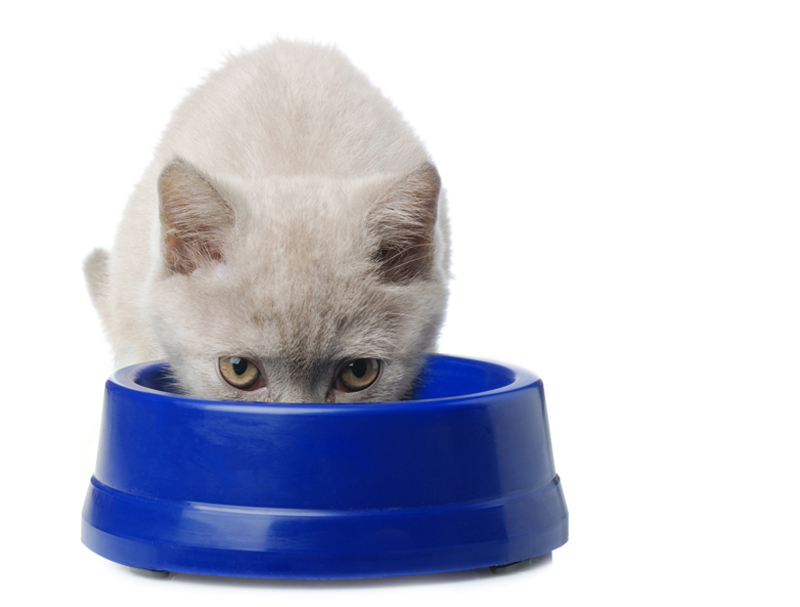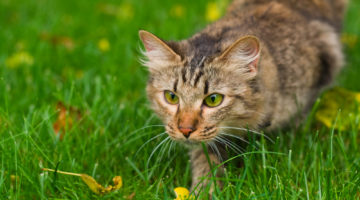How to get your fussy feline eating healthy.
Alice’s tabby cat, Reynold, was five years old before she learned about the health problems associated with poor quality commercial foods. By that time, Reynold had become a low-end dry food addict and refused to touch anything else. “I lost count of the number of different food samples I brought home from the pet food store,” Alice says. “He turned his nose up at most of them, and when he did eat them he got diarrhea. I hated the thoughts of continuing to give him unhealthy food, but I didn’t know what else to do.”
It’s a common problem. More and more people are seeing the benefits of raw and high quality canned foods for their cats, but meet with failure when they try to switch their felines to a better diet. A primary reason is that, like Reynold, cats tend to flatly reject any new food, especially one as radically different from their usual fare as raw meat.
To a large extent, your cat’s food preferences were formed during kittenhood. For example, many cats who have been fed poor quality kibble their whole lives simply don’t recognize anything else as “food”. Even just changing brands or flavors can be a major challenge. Cats dislike change in general, and messing with their dinner habits may not be welcome. Nevertheless, with the right approach, it is almost always possible to convert your cat to a better diet.
- For cats who have food available 24/7 (“free choice”), the first step is a timed meal schedule. Leave the food out for 30 to 60 minutes in the morning and evening, and put it away the rest of the time. Your cat will not starve to death in 12 hours. The eat-fast-eat schedule is more natural to carnivores, and gives their tummies time to rest between meals. Don’t restrict the amount; put out plenty of food. The big advantage of timed meals is that the cat will be hungry at mealtime, and thus more willing to try new things.
- Plan ahead when making the transition from one food to another. Don’t let yourself run out of the old food and then slap down a bowl of something new. Even if the cat will eat it, the sudden switch can cause tummy upset.
- If adding raw food to your cat’s diet, or switching from dry to canned or raw, use caution and go slowly. These forms of food are so vastly different that your cat’s tummy will take some time to get used to them. In the case of dry food, it may be easier to switch to canned food first, and then, if you desire, move to raw later.
- If you’re planning to make your cat’s meals yourself, do your homework! Cats have specific, unique nutrientrequirements, and it’s easy to miss something when using a recipe that claims to be adequate for both dogs and cats. Consult with a holistic vet who is knowledgeable about feline nutrition, read different books and articles, or join an Internet e-mail list or bulletin board so you can gather as much information as possible. Don’t try to simplify the diet by skipping supplements as this can easily cause serious health problems for your cat.
Making the switch
For the first few days, feed 75% of the old food mixed with 25% new. Then switch to 50% each of old and new food for a few more days, before moving to 25% old food and 75% new food. Finally, you can switch to all new food. This staged approach helps your cat’s gut bacteria gear up to handle the new food properly. Some cats require an even more gradual approach. For instance, on the first day you might mix only 5% new food with the old, and go up in 5% increments every few days over a period of several weeks.
If your cat refuses to touch dry food with canned or raw mixed with it, offer only the new food for the first half of the meal period. Many cats will be hungry enough to at least taste it. If not, try one or more of these tricks:
- Start with plain meat, without veggies or supplements.
- Lightly brown the meat.
- Sprinkle a handful of kibbles on top of the canned or raw food.
- Crush the dry food into crumbs. Make tiny, bite-sized meatballs of the new food, and roll them in the crumbs.
Make sure your cat is eating at least a little at each meal. If he isn’t, scale back on the percentage of new food, or offer his favorite food by itself. Cats (especially if they’re overweight) can get into big trouble if they miss even a few meals since they can quickly develop hepatic lipidosis (fatty liver disease). It is expensive to treat, and not all cats survive.
For the first two weeks after completing the changeover to the new food, closely monitor your cat’s appetite, stool quality and energy level, and be alert for unusual symptoms – itchiness, runny eyes, etc. – that could be telling you the food is not right for him.
What if he gets diarrhea?
Many (if not most) cats will experience a change in stool, including diarrhea. As long as your cat is still eating well and acting fine, diarrhea is nothing to worry about; in fact, it’s pretty normal, and will often persist for a week or two. However, if your cat has additional symptoms, such as lethargy, poor appetite, or persistent vomiting, stop the new food and contact your veterinarian; there may be something else going on. There are several ways to prevent or resolve diarrhea due to diet change:
- Make the switch very slowly; or decrease the amount of new food and go back to a larger proportion of old food.
- Add a digestive enzyme supplement. You can get one made for animals, or use a human version from the health food store. Enzymes should be plantbased (not pancreas extracts) and include protease, lipase, amylase, and cellulase.
- Add probiotics to help balance the gut’s bacterial population. Probiotics are “friendly” bacteria and include Lactic acidophilus and Bifidobacterium bifidum.
Keep in mind that variety is critically important in your cat’s diet. As tempting as it is to stick with one recipe or flavor that your cat prefers, be sure to provide different choices. This ensures your cat is getting a good balance of nutrients, vitamins, and minerals. Your cat’s skin and coat quality, energy, activity level and appetite are the best indicators of whether the food is compatible with his system and providing ample nutrition.
“It’s taking time and patience, but Reynold is gradually starting to eat healthier foods,” says Alice. “It’s a load off my mind, and he’s already starting to look better.”







No Comment